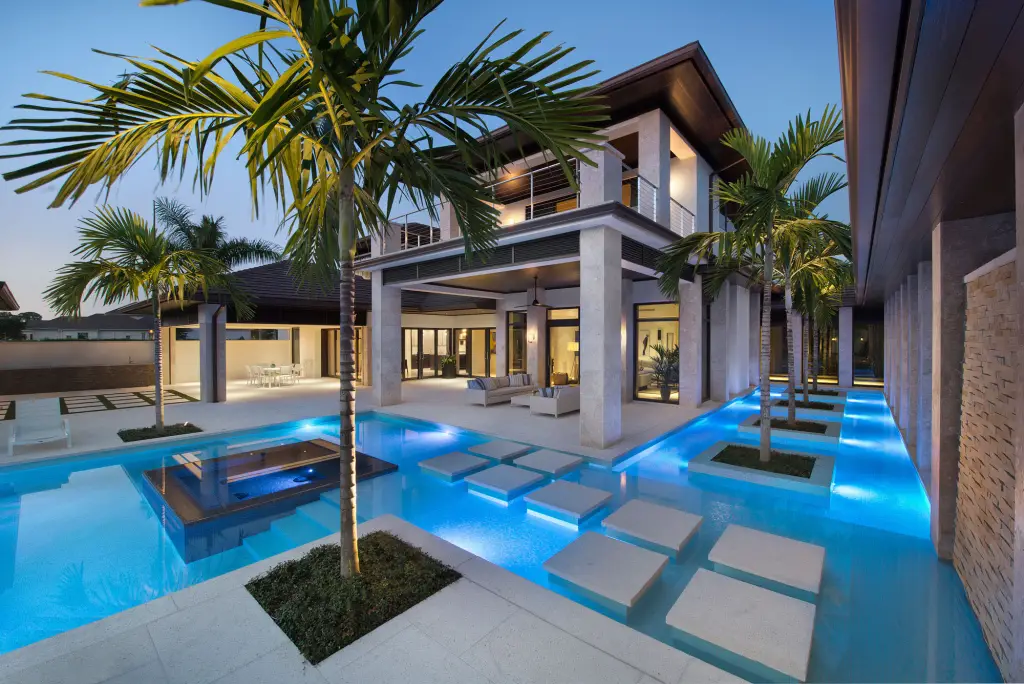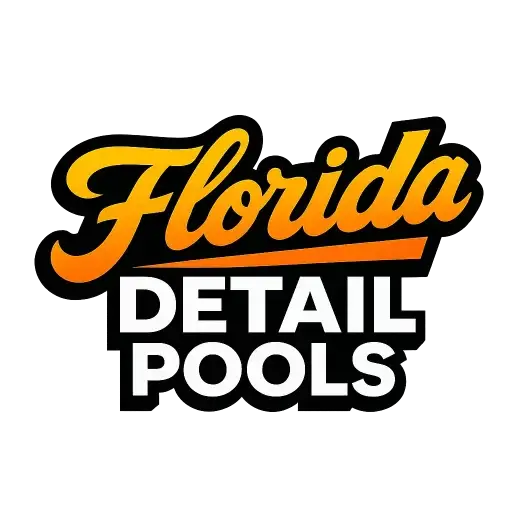How to Keep Pool Water Clear After Heavy Florida Rain
Heavy rainfall events throughout Charlotte County can transform crystal-clear pools into murky, cloudy disasters within hours, creating frustrating cleanup challenges for pool owners from Port Charlotte to Punta Gorda. Florida’s intense storm systems deliver massive volumes of water that dilute chemicals, introduce contaminants, and overwhelm filtration systems faster than most homeowners anticipate.Understanding how to respond quickly and effectively to rain-induced water clarity problems prevents minor issues from escalating into major restoration projects requiring professional intervention and expensive chemical treatments. The key lies in immediate assessment, strategic chemical adjustment, and enhanced circulation that addresses the root causes of post-storm cloudiness.
North Port and Rotonda pool owners face particular challenges during storm season, where afternoon thunderstorms can dump several inches of rain in short periods, creating conditions that require rapid response to prevent algae establishment and water quality deterioration.
Understanding Rain’s Impact on Pool Chemistry
Chemical Dilution Effects
Primary Chemical Disruption Heavy rainfall creates immediate chemical imbalances that affect water clarity:
- Chlorine levels drop below effective sanitization thresholds
- pH levels shift due to acidic rainwater introduction
- Alkalinity buffers become insufficient for chemical stability
- Stabilizer concentrations reduce, making remaining chlorine less effective
Secondary Chemical Reactions Diluted chemical levels create cascading effects that worsen water clarity:
- Reduced sanitizer effectiveness allows bacterial growth
- pH imbalance affects chemical distribution and effectiveness
- Mineral precipitation from chemical interactions clouds water
- Professional water chemistry restoration addresses complex imbalances
Contaminant Introduction
Atmospheric Contamination Rainwater carries various pollutants that affect pool water quality:
- Dust, pollen, and airborne particles create immediate cloudiness
- Organic matter from trees and vegetation introduces nutrients
- Urban pollutants and atmospheric contaminants affect chemical balance
- Fertilizer runoff from landscaping promotes algae growth
Surface Runoff Problems Heavy rain creates runoff that introduces additional contamination:
- Deck and surrounding area contaminants wash into pools
- Landscaping debris and soil particles cloud water immediately
- Pet waste and organic matter from yards create bacterial loads
- Professional assessment may be needed for severe contamination events
Immediate Post-Rain Response Protocol
First 2 Hours: Critical Assessment and Action
Water Level Management Address overflow and water level issues immediately:
- Lower water levels to proper skimmer operation if overflow occurred
- Use submersible pumps for significant water removal
- Check equipment operation at new water levels
- Document water level changes for insurance or professional consultation
Initial Chemical Testing Rapid chemical assessment guides immediate treatment needs:
- Test chlorine, pH, and alkalinity using reliable equipment
- Compare results to pre-storm levels if documented
- Identify most critical chemical deficiencies requiring immediate attention
- Professional emergency pool service available for severe imbalances
Debris and Contamination Removal
Physical Cleaning Priority Remove visible contamination before chemical treatment:
- Skim surface debris thoroughly to prevent decomposition
- Empty and clean skimmer baskets that may be overwhelmed
- Remove large debris from pool bottom before it decomposes
- Clean surrounding deck areas to prevent additional runoff
Filtration System Assessment Evaluate filtration capacity for increased contamination loads:
- Check filter pressure and clean or backwash if elevated
- Inspect pump baskets for debris that could restrict flow
- Verify proper equipment operation after water level changes
- Consider professional filter service for severe contamination

Strategic Chemical Restoration
Shock Treatment Protocols
Immediate Oxidation Needs Heavy shock treatments address contamination and restore sanitizer levels:
- Use calcium hypochlorite shock for powerful oxidation without stabilizer buildup
- Apply 1-2 pounds per 10,000 gallons depending on contamination level
- Add shock during evening hours to prevent immediate UV degradation
- Maintain continuous circulation during shock treatment for even distribution
Multi-Stage Shock Approach Severe contamination may require multiple shock applications:
- Initial shock treatment addresses immediate contamination
- Secondary treatment 12-24 hours later handles remaining organic load
- Monitor chlorine levels between treatments to guide additional applications
- Professional consultation recommended for persistent cloudiness after multiple treatments
pH and Alkalinity Correction
Acidic Rain Compensation Rainwater typically lowers pH requiring systematic correction:
- Test pH immediately and adjust using sodium carbonate if low
- Restore alkalinity to 80-120 ppm range for chemical stability
- Make gradual adjustments to prevent chemical precipitation
- Allow circulation time between adjustments for proper mixing
Chemical Addition Sequence Proper chemical addition order prevents adverse reactions:
- Adjust pH first to optimize subsequent chemical effectiveness
- Add shock treatment after pH correction for maximum effectiveness
- Apply algaecide after shock treatment has had time to work
- Professional chemical balancing services ensure optimal procedures
Enhanced Circulation and Filtration
Circulation Optimization
Extended Operating Schedules Post-rain periods require increased circulation for recovery:
- Run pumps continuously for 24-48 hours after heavy rain
- Use highest safe flow rates to maximize water movement
- Check return jets for proper flow and adjust if restricted
- Monitor energy consumption and equipment performance during extended operation
Dead Zone Elimination Ensure circulation reaches all pool areas during recovery:
- Brush walls and corners to suspend settled particles
- Direct return jets to create circulation in typically stagnant areas
- Use pool brush to create additional water movement during treatment
- Professional assessment identifies circulation improvements for recurring problems
Filter Enhancement
Intensive Filtration Programs Enhanced filtration accelerates water clearing:
- Clean or backwash filters more frequently during recovery period
- Consider temporary filter upgrades for severe contamination
- Monitor pressure gauges closely and clean when elevated
- Replace filter media if severely contaminated or clogged
Supplemental Filtration Additional filtration equipment may be needed for severe cases:
- Portable filtration units can supplement existing systems
- Flocculant treatments bind fine particles for easier removal
- Professional equipment provides capabilities beyond homeowner resources
- Coordinate with professionals for severe contamination requiring specialized treatment
Algae Prevention During Recovery
Proactive Algae Management
Immediate Prevention Measures Prevent algae establishment during vulnerable recovery period:
- Apply algaecide immediately after shock treatment effectiveness is confirmed
- Maintain continuous circulation to prevent stagnant areas
- Monitor and maintain adequate chlorine levels throughout recovery
- Brush surfaces daily to prevent algae attachment during chemical restoration
Environmental Control Address conditions that promote algae growth:
- Remove organic debris that provides algae nutrition
- Maintain proper chemical balance that inhibits algae establishment
- Ensure adequate circulation eliminates algae-friendly dead zones
- Professional algae prevention programs provide expert guidance
Long-Term Algae Prevention
Sustainable Treatment Approaches Establish routines that prevent future algae problems:
- Weekly algaecide applications during storm season
- Enhanced circulation schedules during high-risk periods
- Regular phosphate testing and removal to eliminate algae nutrients
- Professional monitoring during challenging weather patterns
Professional Intervention Guidelines
When to Call Professionals
Situation Assessment Criteria Certain conditions require professional expertise:
- Water remains cloudy after 48 hours of intensive treatment
- Chemical levels don’t respond to homeowner adjustment attempts
- Equipment appears damaged or operates improperly after storms
- Multiple treatment attempts fail to restore water clarity
Emergency Service Situations Some conditions require immediate professional response:
- Equipment failure during recovery process
- Severe contamination from flooding or unusual runoff sources
- Chemical imbalances that create unsafe swimming conditions
- Insurance documentation needs for storm-related damage
Professional Service Advantages
Specialized Equipment Access Professional services provide capabilities beyond homeowner resources:
- Commercial-grade shock treatments and specialized chemicals
- High-capacity filtration and water processing equipment
- Professional testing equipment for accurate chemical analysis
- Specialized cleanup equipment for severe contamination
Expertise and Experience Professional knowledge ensures efficient problem resolution:
- Understanding of complex chemical interactions during recovery
- Experience with severe contamination and unusual situations
- Access to commercial products unavailable to homeowners
- Coordination with insurance companies for storm damage claims
Regional Service Resources
For comprehensive post-rain pool recovery services designed specifically for Charlotte County storm conditions, Florida Detail provides expert assessment and professional treatment that quickly restores water clarity while preventing future problems.
Additional specialized storm recovery expertise is available through PortCharlottePoolServices.com and NorthPortPoolServices.com, which understand local storm patterns and effective recovery procedures.
For detailed information about storm recovery techniques and advanced water treatment methods, UnlimitedManiac.com provides comprehensive resources covering the latest innovations in post-storm pool recovery and water quality restoration.
Prevention Strategies for Future Storms
Pre-Storm Preparation
Chemical Pre-Loading Prepare pools for anticipated dilution:
- Increase chlorine levels slightly before major storms
- Ensure chemical feeders are full and functioning properly
- Test and adjust pH and alkalinity to optimal ranges
- Stock adequate chemicals for post-storm treatment
Physical Preparation Minimize contamination introduction:
- Secure loose items that could become debris
- Trim overhanging vegetation that could fall into pools
- Clean deck areas to prevent runoff contamination
- Cover pools if safe to do so before severe weather
Long-Term Improvements
Infrastructure Enhancements Permanent improvements reduce future storm impact:
- Enhanced drainage around pool areas prevents contaminated runoff
- Landscaping modifications reduce debris introduction
- Equipment upgrades provide better recovery capabilities
- Professional consultation identifies site-specific improvements
Automation Integration Technology helps manage storm recovery:
- Automated chemical feeders maintain levels despite dilution
- Remote monitoring enables immediate response to problems
- Programmable equipment adjusts operation for storm recovery
- Professional installation ensures optimal storm recovery automation
Recovery Timeline and Expectations
Typical Recovery Schedules
Minor Storm Impact Light to moderate rainfall recovery typically requires:
- 4-6 hours for initial chemical adjustment and shock treatment
- 12-24 hours for water clarity restoration with proper treatment
- 24-48 hours for complete chemical stabilization
- Professional consultation if recovery doesn’t proceed as expected
Major Storm Recovery Severe contamination may require extended recovery periods:
- 24-48 hours for initial contamination control and basic clarity
- 3-5 days for complete restoration to pre-storm conditions
- Multiple treatment cycles may be necessary for severe cases
- Professional intervention often necessary for optimal results
Maximize Your Storm Recovery Success
Effective post-rain pool recovery requires rapid assessment, systematic chemical treatment, and enhanced circulation that addresses both immediate contamination and underlying chemical imbalances created by rainfall dilution.
Understanding proper recovery procedures and knowing when to seek professional help prevents minor rain-related problems from becoming major restoration projects that require expensive intervention and extended pool downtime.
Pool cleaning in Charlotte County professionals understand the specific challenges created by Southwest Florida’s storm patterns and provide expert guidance that ensures rapid, effective recovery while preventing recurring problems.
Restore Your Pool’s Clarity Today
Transform post-storm pool problems into manageable recovery procedures through systematic treatment approaches that address contamination while restoring proper chemical balance quickly and effectively.
Explore professional storm recovery services and expert guidance at https://FloridaDetail.com to develop comprehensive recovery strategies that handle Florida’s challenging storm conditions while protecting your pool investment. Don’t let heavy rain compromise your swimming enjoyment—implement proven recovery techniques that deliver rapid results and long-term water quality success.
